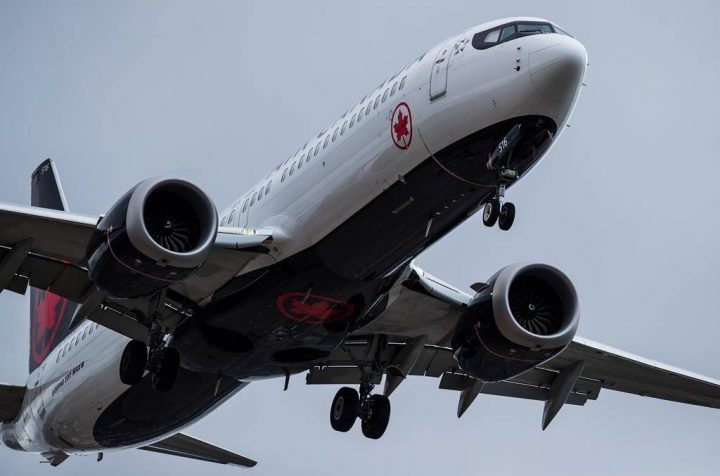The Boeing 737 MAX will carry passengers again, possibly before the end of 2020, but its success in the years after it returns to service will depend on customer confidence and how long the COVID-19 pandemic drags on.

The worldwide fleet was grounded in March 2019 after the second of two deadly crashes, which killed a total of 346 people, including 18 Canadians.
READ MORE: U.S. flight regulator orders defect inspection for all Boeing 737 Max planes
Boeing saw 43 orders for the 737 MAX get cancelled in July, meaning the total number of MAX order cancellations for 2020 hit 416.
When you take into account the number of additional orders that are unlikely to materialize (for example, due to airline bankruptcies), Boeing’s order backlog for the 737 MAX dropped to 3,543 in July 2020.
That is still a considerable number of orders for a plane with a list price of at least US$100 million.
But with the huge downturn in aviation in 2020 due to COVID-19, Boeing executives will be praying for an early vaccine as well as an early re-certification by regulators.
Before the 737 MAX was grounded, Boeing had planned to produce 57 of the planes a month. It might take years for that to happen. In its most recent quarterly results, the company says it’s hoping it can make 31 a month by 2021.

As of August 2020, the International Civil Aviation Organization, predicts that passenger air travel numbers will drop by between 52 per cent and 59 per cent worldwide in 2020, when compared with 2019.
The number could be as high as 66 per cent in North America.

Get weekly money news
Most analysts believe it will be years before air travel returns to pre-pandemic levels.
According to the management consulting firm Oliver Wyman, two-thirds of the worldwide fleet of 27,884 large aircraft were sent into storage in the early months of the pandemic.
It said, as of July 10, about one-third returned to service, but that still leaves thousands of aircraft parked up.
“Boeing has built more than 450 aeroplanes that are sitting on the ground, so that number of aeroplanes coming into the market is going to take away a lot of demand,” said Ernie Arvai, president of Air Insight Group.
“Boeing will need to absorb those aeroplanes first. So production rates will remain relatively low for quite some time.”

Boeing shut down the production line of the grounded 737 MAX at the end of 2019, but resumed, at lower production rate, in May 2020.
With so many planes in storage, and airlines suffering huge financial losses, many operators will be reluctant to place new orders and will struggle to accept the planes to which they have already committed.
Taking on new 737 MAX aircraft could be especially challenging when their existing fleet may not have the same reputation issues as the MAX.
“The problem that Boeing has is their contract indicated that if they couldn’t deliver aeroplanes within the year of the scheduled timing, the customer could walk away from any or all of that order,” Arvai said.
“So this is why we’ve seen a fair number of cancellations at Boeing, as there are no penalties for walking away, given the delay that Boeing had with the aircraft grounding.”
In Boeing’s favour, the major carrot offered by the 737 MAX is its fuel-efficiency, when compared to older variants, but ultimately, like any industry, air travel is driven by customer demand.
If passengers decide they don’t want to fly on a 737 MAX, airlines will be forced to listen.
READ MORE: Air Canada to revamp Aeroplan program in effort to recover from coronavirus
Air Canada and WestJet are among the airlines that will inform passengers of the model of aircraft at the time of booking, though late changes to the aircraft type on the day of a flight are always a possibility.
Air Canada currently has 24 Boeing 737 MAX aircraft sitting on the ground, with 26 more on order.
WestJet has 12, with 43 more scheduled for delivery in the coming years.
“What no one knows yet is what the consumer’s reaction is going to be to the MAX (returning), said Arvai, who noted that passengers can now be much more informed than they were in the past.
“In previous situations, the DC-10, the Lockheed Electra, the de Havilland Comet — where we’ve had safety issues and crashes caused groundings of the aircraft — that was well before the impact of social media and the Internet.”
This month, the U.S. Federal Aviation Administration (FAA) said it is proposing requiring four key design and operating changes before the MAX can return to service.
READ MORE: FAA mulls ordering 4 safety fixes to Boeing 737 MAX as fleet remains grounded
Those will be: updated flight-control software; revised display-processing software to generate alerts; a revision of certain flight-crew operating procedures; and changes in the routing of some wiring bundles.
Transport Canada and the European Union Aviation Safety Agency both have their own specific concerns about the MAX’s safety before they allow it to return to service.









Comments